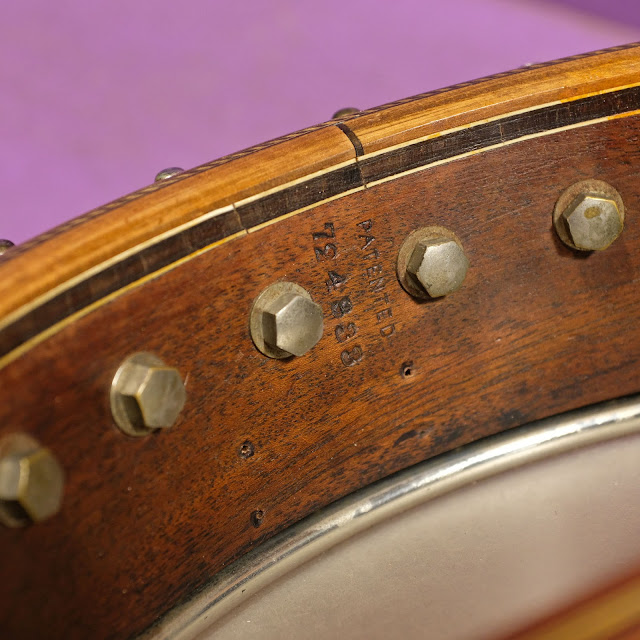1920s Lange-made Orpheum No 3 Tenor Banjo
Here's that second Orpheum No 3 I promised! While the first one is almost a time capsule, this banjo has definitely seen a bit of the road. It's been played hard, has mismatched bits here and there, a refinished rim, and just spews-out well-traveled vibes.
Unsurprisingly, it sounds almost identical to its well-heeled brother-banjo -- which is to say, in my opinion... dreamy. These Lange-built banjos just have that voice. It's a mix of sweet and poppy/clucky that you just don't hear a lot in other tenors (or 4-strings in general) from the time. You cab push these really hard with a pick and get a ton of volume before the sound ever feels like it's compressing too much.
Work included: a new Remo Renaissance head, fret level/dress, patch to a minor break in the very end of the fretboard, replacement tailpiece (and endbolt), replacement tuner button, much cleaning and tightening-up in general, and a good setup. Action is spot-on at 1/16" at the 12th fret and it has a straight neck, too. String gauges are currently 32w, 20w, 13, 9 for CGDA standard tuning.
Scale length: 20 7/8"
Nut width: 1 3/16"
String spacing at nut: 7/8"
String spacing at bridge: 1 3/8"
Nut width: 1 3/16"
String spacing at nut: 7/8"
String spacing at bridge: 1 3/8"
Head diameter: 11 1/4" with new Remo Renaissance head
Side depth: 2 3/4"
Rim wood: ply maple(?) with mahogany veneer
Neck wood: mahogany
Fretboard: ebonized maple
Neck wood: mahogany
Fretboard: ebonized maple
Neck shape: flat board with medium soft-V shape
Bridge: maple/ebony 5/8" original
Nut: original bone
Tonering type: solid hoop over brads (archtop setup) with outer thin ring
Weight: 6 lb 8 oz
Condition notes: rim is refinished in a dull satin and lacks original Lange/Orpheum tag, three or four replacement hook/nuts, 3 types of geared tuner (all non-original but all vintage and all working) at the headstock, replacement tailpiece, replacement head, some old wear/repair to the backstrapping below the headstock on the back of the neck, and lots of general wear/tear throughout. Colors in the purfling are quite faded, the pearl in the board reflects not all on the same plane, and the board itself has a lot of playwear but is good to go. Still -- one can tell straightaway that this is a fancy instrument and of excellent quality.
It comes with: its original hard case in pretty-beat condition.
I love those headstock inlays!
The olive green of the backstrapping would've been a sea-green/turquoise color when new.
The heel carving is awfully pretty, isn't it?
I replaced one (the D-string tuner) of the mismatched buttons with an older, ivoroid one that blends a little better.
The serial on the dowel looks like 13801 to me, which places this around 1921.
























Comments